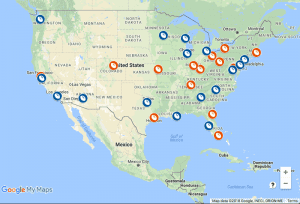More recently, WTO members have adopted additional disciplines covering rules of origin that apply to least developed countries in the context of non-reciprocal preferences (the 2013 Bali Ministerial Decision on Rules of Origin for Least Developed Countries and the 2015 Nairobi Ministerial Decision on Rules of Origin for Least Developed Countries). The CRO and the TCRO have developed a comprehensive architectural design within the framework of which the harmonization work programme is to be completed. These include the general rules set out in eight articles provisionally entitled “Scope”; the Harmonized System; definitions; determination of origin; Residual rules of origin; minimal operations or processes; special provisions; and de minimis; three annexes: Appendix 1: Wholly obtained goods; Appendix 2: Product Rules – Essential Processing; and Appendix 3: Minimum Operations or Processes. Preferential rules or rules of origin are those that apply in mutual trade preferences (i.e. . B regional trade agreements or customs unions) or in non-reciprocal trade preferences (i.e. preferences for developing countries or LDCs). Rules of origin have become a difficult issue in international trade, not only because they represent a highly technical area of rule-making, but also because their designation and application are not harmonized worldwide. The lack of harmony is even more remarkable in the era of regionalism, where more and more free trade agreements (FTAs) are concluded that create the spaghetti bowl effect. [2] In principle, free trade agreements and their rules of origin should be notified to the WTO as an obligation of Members.
[7] However, rules of origin in free trade agreements and autonomous trade agreements (e.g. B GSP schemes) are not subject to any essential WTO requirements. Indeed, the Agreement on Rules of Origin does not regulate how rules of origin are to be formulated and implemented in a free trade agreement or GSP. There is only a brief joint declaration on preferential rules of origin, which sets out certain standards and recommendations for the formulation of preferential rules of origin. [8] The fact that preferential rules of origin do not fall within the scope of the WTO adds even more divergence to the “spaghetti bowl” of rules of origin: each free trade agreement and each autonomous trade regime can formulate its own rules of origin. Due to the rapid growth of regionalism, hundreds of rules of origin are currently applied in hundreds of free trade agreements. According to the WTO, as of 4 January 2019, 291 RTAs will be in force – only those notified to the WTO Secretariat will apply. [9] According to the International Trade Centre (ITC), more than 440 free trade agreements are in force at the end of March 2019. [10] (i) Minimum percentage of the value added of finished products (structural or direct verification): Manufacturing or processing operations carried out in the country of origin must reach a certain level, i.e. the percentage of the value they add to the finished products must reach or exceed a certain threshold in order for them to originate there. This test requires a balance between the value of the content created regionally or locally and that of the final product. As a result, the stringency of the rules of origin would increase with the regional or national content threshold.
For example, a rule that requires 40% regional value content will be stricter than a rule that requires 35%. The Agreement on Rules of Origin aims to harmonise non-preferential rules of origin and to ensure that these rules do not themselves create unnecessary barriers to trade. The Agreement contains a work programme for the harmonisation of rules of origin to be implemented in cooperation with the World Customs Organisation (WCO) after the entry into force of the World Trade Organisation (WTO). Rules of origin have become increasingly controversial as preferential customs regions and the anti-dumping regimes that require them have emerged like mushrooms. As a result, most international agreements now contain provisions that allow countries to negotiate specific criteria for specific products. For example, NAFTA has adopted the rule that any tea fermented or packaged in a NAFTA country should be considered to meet the rule of origin, regardless of where it was originally grown. For example, in Vietnam, goods exported to an importing country under the non-preferential regime may require a non-preferential certificate of origin certified by the Vietnamese Chamber of Commerce and Industry. The Council is also responsible for issuing the Certificate of Preferential Origin Form A when the goods are exported to a GSP granting country.
However, if the goods are traded under a free trade agreement, the issuing authority is a local office of the Import and Export Administration, which reports directly to the Ministry of Industry and Trade. In fact, non-preferential rules of origin in the WTO are no more harmonized than in free trade agreements. Despite enormous efforts, the work programme to harmonize non-preferential rules of origin has not yet made significant progress, which means that there are still no common rules of origin within the WTO for non-preferential purposes. During the so-called “transition” period, the formulation and implementation of non-preferential rules is literally left to the discretion of the members. [11] The only difference with preferential rules of origin is that non-preferential rules of origin are subject to more stringent requirements in WTO agreements, in particular in the Agreement on Rules of Origin and the Agreement on Trade Facilitation. [12] Preferential origin is linked to trade agreements that grant members access to the domestic market at preferential tariffs. During the transition period (i.e. until the entry into force of the new harmonized rules), Members shall ensure that: (a) the rules of origin, including specifications for the examination of substantial conversion, are clearly defined; (b) rules of origin are not used as a trade policy instrument; (c) the rules of origin themselves do not have restrictive, distorting or disruptive effects on international trade and do not require compliance with conditions unrelated to the manufacture or processing of the product concerned; (d) the rules of origin applied to trade are not stricter than those applied to determine whether the product is present in the internal market and do not discriminate between members (GATT most-favoured-nation principle).
However, with respect to rules of origin applied to government procurement, Members are not required to assume commitments other than those already undertaken under gatt 1994 (the exception for national treatment of government procurement set out in Article III(8) of the GATT). (e) the rules of origin are applied in a consistent, uniform, impartial and proportionate manner; (f) Rules of origin are based on a positive standard. Negative norms are permitted either in the context of a clarification of a positive standard or in individual cases where a positive determination or origin is not required; (g) the rules of origin are published without delay; (h) where, on request, origin assessments are issued as soon as possible and no later than 150 days after that request, they shall be made available to the public; Confidential information may only be disclosed if this is necessary in the context of legal proceedings. Origin assessments shall remain valid for three years, provided that the facts and conditions remain comparable, unless a decision to the contrary to that assessment is taken in the context of a review referred to in point (j). This prior origin information is considered a major innovation of the Agreement; (i) the new rules of origin or their amendments do not apply retroactively; (j) any administrative act relating to the determination of origin may be appealed without delay by the courts, arbitral or administrative tribunals or by a procedure independent of the determining authority; these results may alter or even reverse the determination; (k) confidential information will not be disclosed without the express consent of the person providing it, unless required in connection with legal proceedings. The WTO administers the Agreement on Rules of Origin. It holds committees on rules of origin. Although most of the WTO`s work focuses on non-preferential rules of origin, the current initiative on rules of origin for least developed countries is important work that the WTO is continuing.
It obliges members that undertake to submit submissions on their rules of origin under the preferential treatment accorded to least developed countries under ministerial declarations. The WTO website on non-preferential rules of origin provides an archive of documents on non-preferential rules of origin in member states. [25] It also provides a database on preferential rules of origin notified under the LDC initiative. [26] As part of a joint initiative with the WCO and the WTO, the International Trade Centre presents the Guidelines for the Facilitator of Origin[31], which provide free and user-friendly access to the ITC database on rules of origin and origin documentation in hundreds of trade agreements. .


